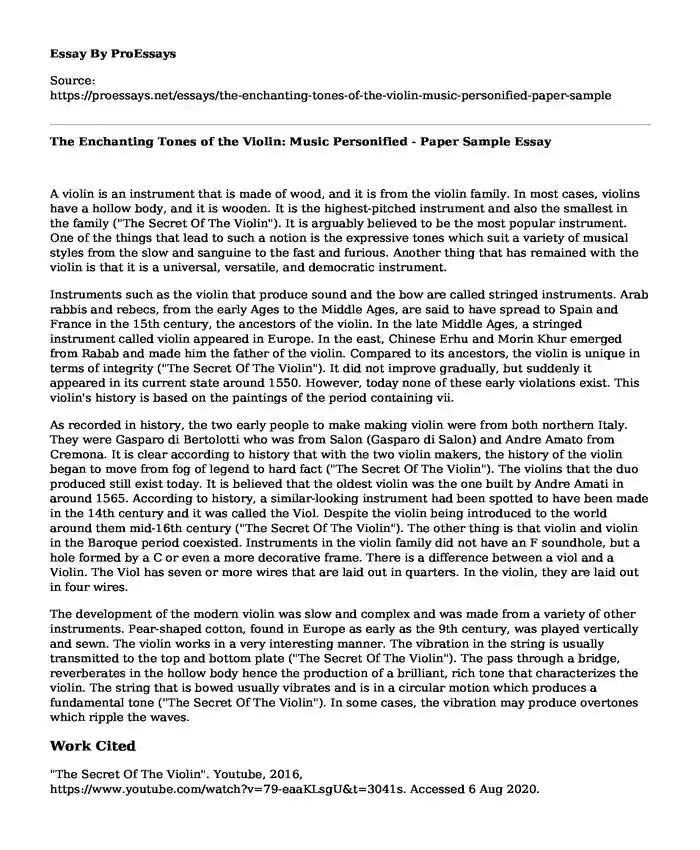A violin is an instrument that is made of wood, and it is from the violin family. In most cases, violins have a hollow body, and it is wooden. It is the highest-pitched instrument and also the smallest in the family ("The Secret Of The Violin"). It is arguably believed to be the most popular instrument. One of the things that lead to such a notion is the expressive tones which suit a variety of musical styles from the slow and sanguine to the fast and furious. Another thing that has remained with the violin is that it is a universal, versatile, and democratic instrument.
Instruments such as the violin that produce sound and the bow are called stringed instruments. Arab rabbis and rebecs, from the early Ages to the Middle Ages, are said to have spread to Spain and France in the 15th century, the ancestors of the violin. In the late Middle Ages, a stringed instrument called violin appeared in Europe. In the east, Chinese Erhu and Morin Khur emerged from Rabab and made him the father of the violin. Compared to its ancestors, the violin is unique in terms of integrity ("The Secret Of The Violin"). It did not improve gradually, but suddenly it appeared in its current state around 1550. However, today none of these early violations exist. This violin's history is based on the paintings of the period containing vii.
As recorded in history, the two early people to make making violin were from both northern Italy. They were Gasparo di Bertolotti who was from Salon (Gasparo di Salon) and Andre Amato from Cremona. It is clear according to history that with the two violin makers, the history of the violin began to move from fog of legend to hard fact ("The Secret Of The Violin"). The violins that the duo produced still exist today. It is believed that the oldest violin was the one built by Andre Amati in around 1565. According to history, a similar-looking instrument had been spotted to have been made in the 14th century and it was called the Viol. Despite the violin being introduced to the world around them mid-16th century ("The Secret Of The Violin"). The other thing is that violin and violin in the Baroque period coexisted. Instruments in the violin family did not have an F soundhole, but a hole formed by a C or even a more decorative frame. There is a difference between a viol and a Violin. The Viol has seven or more wires that are laid out in quarters. In the violin, they are laid out in four wires.
The development of the modern violin was slow and complex and was made from a variety of other instruments. Pear-shaped cotton, found in Europe as early as the 9th century, was played vertically and sewn. The violin works in a very interesting manner. The vibration in the string is usually transmitted to the top and bottom plate ("The Secret Of The Violin"). The pass through a bridge, reverberates in the hollow body hence the production of a brilliant, rich tone that characterizes the violin. The string that is bowed usually vibrates and is in a circular motion which produces a fundamental tone ("The Secret Of The Violin"). In some cases, the vibration may produce overtones which ripple the waves.
Work Cited
"The Secret Of The Violin". Youtube, 2016, https://www.youtube.com/watch?v=79-eaaKLsgU&t=3041s. Accessed 6 Aug 2020.
Cite this page
The Enchanting Tones of the Violin: Music Personified - Paper Sample. (2023, Nov 03). Retrieved from https://proessays.net/essays/the-enchanting-tones-of-the-violin-music-personified-paper-sample
If you are the original author of this essay and no longer wish to have it published on the ProEssays website, please click below to request its removal:
- Truth as a Philosophical Concept Essay
- Films Analysis Essay on The Battleship Potemkin and Triumph of the Will
- Essay Example on Into the Wild: A True Adventure Story of Christopher McCandless
- Dances With Wolves - Movie Analysis Essay
- Essay Example on Superheroes: Increasing Diversity in the Modern World
- Essay Example on The Magnificence of Pyramids: Timeless Testaments of History
- Court Participants - Free Report Example







